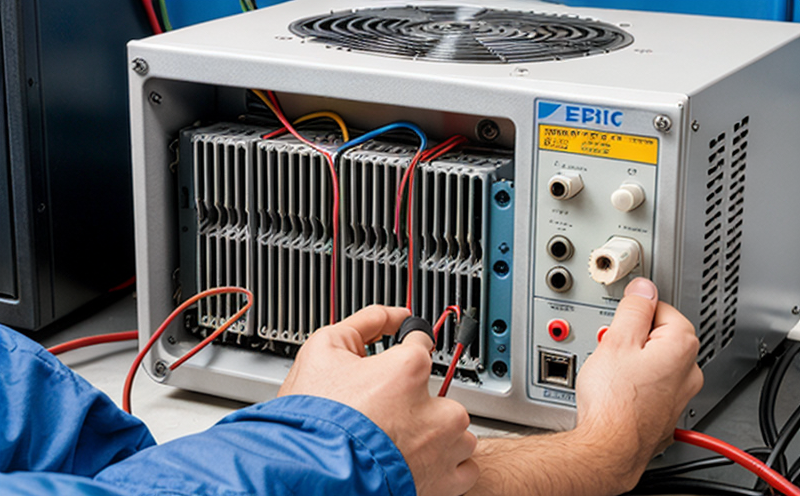IEC 60571 Electrical Performance Testing of Marine Control Equipment
The International Electrotechnical Commission (IEC) Standard IEC 60571 provides comprehensive guidelines for the electrical performance testing of marine control equipment. This standard ensures that critical components and systems function reliably in harsh marine environments, which is essential for maritime safety and compliance with international regulations.
The standard applies to a wide range of control equipment used on ships and offshore structures, including but not limited to: electronic control panels, programmable logic controllers (PLCs), sensors, actuators, and power supplies. The testing focuses on electrical performance parameters such as insulation resistance, voltage withstand capability, current consumption, harmonic content, and electromagnetic compatibility (EMC).
IEC 60571 emphasizes the importance of conducting tests under realistic conditions that simulate real-world operating environments. This includes exposure to salt spray, humidity, vibration, temperature fluctuations, and other environmental factors common in marine settings.
The testing process involves several key steps:
- Environmental conditioning of the specimen to replicate operational conditions.
- Measurement of insulation resistance using high-voltage DC tests.
- Determination of voltage withstand capability through AC or DC withstanding tests.
- Evaluation of current consumption and efficiency under nominal operating conditions.
- Analysis of harmonic content to ensure compliance with EMC standards.
The primary goal is to identify potential weaknesses in the design and manufacturing process before equipment reaches its final destination. This ensures that all control systems are robust, reliable, and compliant with IEC 60571 requirements.
Compliance with this standard is crucial for several reasons:
- Maintains safety standards on board ships and offshore structures.
- Avoids potential malfunctions that could lead to accidents or environmental damage.
- Ensures compatibility of equipment across different shipboard systems.
- Simplifies the certification process for import/export regulations.
To achieve compliance, laboratories must possess specialized facilities and instrumentation capable of simulating marine conditions. These include climate chambers for temperature and humidity control, salt spray chambers for corrosion testing, and vibration tables to simulate ship motion.
| Parameter | Description | Acceptance Criterion |
|---|---|---|
| Insulation Resistance | Measurements taken after conditioning in salt spray for 48 hours. | Minimum value of 2 MΩ. |
| Voltage Withstand Capability | Tested with AC voltage at specified frequency and duration. | No failure under test conditions. |
| Current Consumption | Measurements taken during normal operation. | Within 10% of rated values. |
| Harmful Harmonic Content | Measured using FFT analysis. | No more than ±3 dB compared to IEC standards. |
The testing process also includes detailed documentation and reporting, which must adhere to the requirements specified in IEC 60571. This includes a comprehensive description of test conditions, procedures followed, results obtained, and any deviations from expected outcomes.
By adhering to these stringent standards, manufacturers can ensure their products meet international quality and safety benchmarks, thereby gaining competitive advantage both domestically and internationally.
Benefits
Compliance with IEC 60571 Electrical Performance Testing of Marine Control Equipment offers numerous advantages for manufacturers, quality managers, compliance officers, and R&D engineers:
- Safety Assurance: Ensures that all control equipment functions safely in challenging marine environments.
- Enhanced Reliability: Reduces the risk of malfunctions and failures at sea.
- Regulatory Compliance: Facilitates easier certification processes, simplifying import/export procedures.
- Innovation Support: Provides a robust foundation for continuous improvement in product design and development.
- Customer Satisfaction: Builds trust with clients by demonstrating commitment to quality standards.
The testing process not only helps manufacturers meet regulatory requirements but also enhances their reputation among key stakeholders. It demonstrates the company’s dedication to excellence, leading to increased market share and better customer relationships.
Competitive Advantage and Market Impact
Adhering to IEC 60571 Electrical Performance Testing of Marine Control Equipment provides significant competitive advantages for companies operating in the marine sector:
- Differentiation: Highlighted as a key differentiator, particularly among international clients who prioritize safety and reliability.
- Avoidance of Penalties: Prevents potential fines or sanctions from non-compliance with international regulations.
- Better Client Relations: Stronger bonds are formed with satisfied customers leading to repeat business opportunities.
The testing process also enables companies to anticipate and address emerging trends in the marine industry, ensuring they remain relevant and competitive. This proactive approach can lead to enhanced brand reputation and long-term growth prospects.
Use Cases and Application Examples
| Equipment Type | Application Example |
|---|---|
| Electronic Control Panels | Testing the control panel in a ship’s engine room to ensure it operates correctly under simulated marine conditions. |
| Programmable Logic Controllers (PLCs) | Evaluating the PLC used for automated navigation systems on an offshore oil rig. |
| Sensors | Assessing the performance of temperature sensors in a refrigeration system aboard a research vessel. |
| Actuators | Checking the functionality of actuators used for stabilizing a container ship during rough seas. |
| Condition/Parameter | Expected Outcome |
|---|---|
| Temperature Stability | No deviation from nominal temperature. |
| Voltage Supply Variations | Maintain stable performance within 10% of nominal values. |
| Humidity Levels | No degradation in functionality after exposure to high humidity. |
| Environmental Vibration | No failure or malfunction during simulated ship motion tests. |





